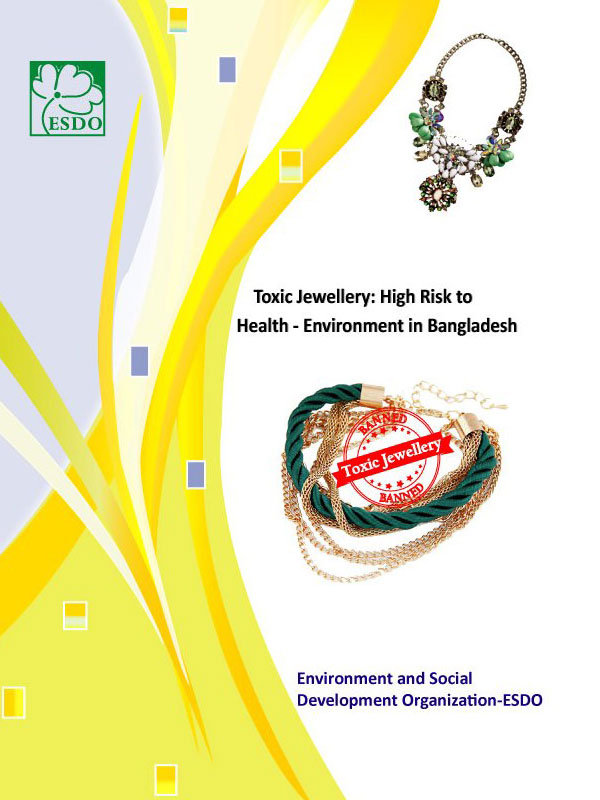Study report On Toxic Jewellery: High Risk to Health and Environment in Bangladesh

Executive Summary
Jewellery is an individual embellishment that people used from ancient time to complement themselves. Jewellery may be made from an extensive range of materials, but gemstones, precious metals, beads, and shells have been widely used. From time to time, lots of things have been added for the production of ornaments. Many of these are elements, like mercury (Hg), lead (Pb), cadmium (Cd), chromium (Cr), nickel (Ni), arsenic (As), etc. and they are harmful to human health. The wide uses of some of these elements in the ornaments are for making them more durable and glossy. Metallic gold is the major primary component of the gold ornaments. In addition to harming the environment, some of these elements have a strong possibility of entering the food chain. Jewelers and regular users of jewellery are particular targets of the excessive presence of toxic metals in these. In the poorly ventilated working space, jewelers continuously inhale the invisible, odorless toxic vapour and suffer from diseases like anxiety, memory loss, skin problems, and poor cognitive function.
No investigation has yet been carried out on the harmful effects of heavy metals used in the jewellery.Environment and Social Development Organization-ESDO has taken a pioneer step to conduct a primary study to find out mainly the toxic metal contents of several pieces of jewellery and also the current level of awareness of the jewellery manufacturers and users about their toxicity.
With this objective in view adults’ and children’s jewellery, such as Earrings, Necklaces, Bracelets, Finger rings, Chains, Bangles were collected from shopping malls, retail shops and tested in the EARTH XRF laboratory in Bangkok. The samples were tested for Titanium Dioxide (TiO2), Arsenic (As), Cadmium (Cd), Lead (Pb), Mercury (Hg), Nickel (Ni), Bromine (Br), Chromium (Cr), Silver (Ag), Manganese (Mn), Iron (Fe), Cobalt (Co), Copper (Cu), Zinc (Zn), Chlorine (Cl) and Calcium (Ca). The test results show that the samples contain high level of As, Pb, TiO2, Cd , Ni, Hg and Zn. Necklaces and chains are found to contain Hg, while the pieces of children’s jewellery contain high levels of Cd, Pb, Ni, As and TiO2. Tests show that most of the earrings contain Cd and Pb in high levels and Hg in medium level. Most of the children’s jewellery contains high level of Pb, Cd, Br and TiO2.
Research results found evidence that cadmium and other toxic elements could leach out of the jewellery when children sucked or scratched them, and ingesting even tiny amounts of the toxic elements can harm children’s brain development. Most of the products have never got screened for their toxic contents and slip through even though the toxic limit surpasses the internationally set safety standard.
High bromine contents of many samples indicate that recycled plastic containing hazardous brominated flame retardants (BFRs) has been used as a filler for the jewellery beads.
The study reveals that the current status of awareness level of the hazards associated with the jewellery items is really low. 55 % of the users mentioned about having a red rash on the skin.On the basis of the collected data some suggestions have been put forwarded.
Key Findings of the Study:
Most of the jewellery items were found to contain Titanium (Ti) in very high concentration (1300-7500) ppm.
Lead (Pb) content was found to be the highest in pendants. Pb concentration varied from 800 ppm to over 10,000 ppm in different jewellery items.The maximum recommended level for adults 0.03 ppm
Cadmium (Cd) were high in concentration in almost every item tested. The concentration varied from 2000 ppm to almost 6500 ppm. Permissible limit of Cadmium for the human body is 0.01 ppm.
Nickel (Ni) was found in greater than 100 ppm (110-800) ppm in almost every sample. Maximum permissible limit of Ni for the human body is 0.04 ppm
Earring and finger ring samples were found to contain Mercury (Hg). Maximum 0.01 ppm of Hg is allowed for human.
Arsenic (As) was detected in every sample in high concentration. 0.05 ppm As is allowable for human body.
Zinc (Zn) concentration varied up to 3500 ppm in different samples.
Bracelet sample found to contain Calcium (Ca) in very high concentration.
12 children jewellery samples contained high level of Br, 1200-3200 ppm and 9 contained BFR. Allowed Br level for adults is 0.1 ppm
For detail report, Please contact with us: info@esdo.org


